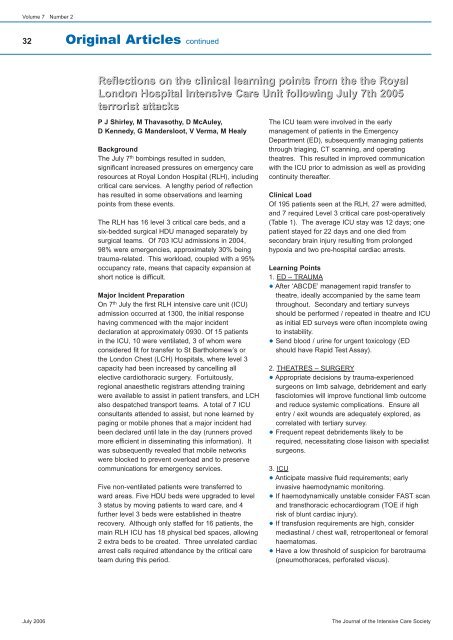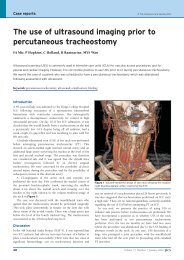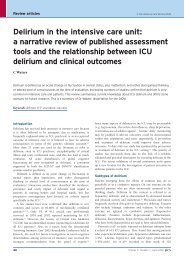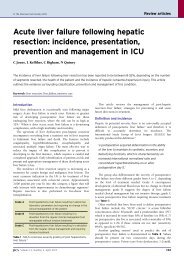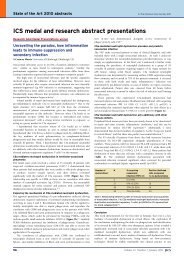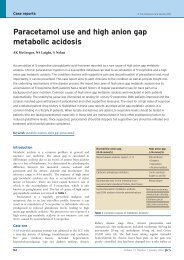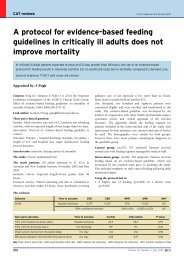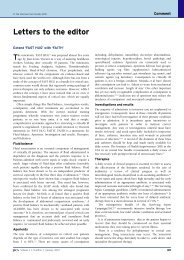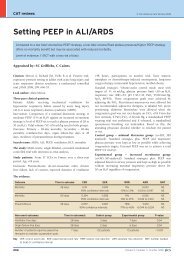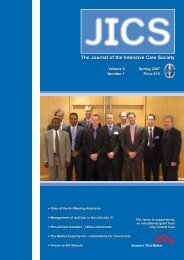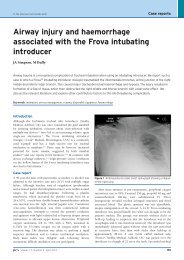Volume 7 Number 2 July 2006 - JICS - The Intensive Care Society
Volume 7 Number 2 July 2006 - JICS - The Intensive Care Society
Volume 7 Number 2 July 2006 - JICS - The Intensive Care Society
Create successful ePaper yourself
Turn your PDF publications into a flip-book with our unique Google optimized e-Paper software.
<strong>Volume</strong> 7 <strong>Number</strong> 2<br />
32<br />
Original Articles continued<br />
Reflections on the clinical learning points from the the Royal<br />
London Hospital <strong>Intensive</strong> <strong>Care</strong> Unit following <strong>July</strong> 7th 2005<br />
terrorist attacks<br />
P J Shirley, M Thavasothy, D McAuley,<br />
D Kennedy, G Mandersloot, V Verma, M Healy<br />
Background<br />
<strong>The</strong> <strong>July</strong> 7 th bombings resulted in sudden,<br />
significant increased pressures on emergency care<br />
resources at Royal London Hospital (RLH), including<br />
critical care services. A lengthy period of reflection<br />
has resulted in some observations and learning<br />
points from these events.<br />
<strong>The</strong> RLH has 16 level 3 critical care beds, and a<br />
six-bedded surgical HDU managed separately by<br />
surgical teams. Of 703 ICU admissions in 2004,<br />
98% were emergencies, approximately 30% being<br />
trauma-related. This workload, coupled with a 95%<br />
occupancy rate, means that capacity expansion at<br />
short notice is difficult.<br />
Major Incident Preparation<br />
On 7 th <strong>July</strong> the first RLH intensive care unit (ICU)<br />
admission occurred at 1300, the initial response<br />
having commenced with the major incident<br />
declaration at approximately 0930. Of 15 patients<br />
in the ICU, 10 were ventilated, 3 of whom were<br />
considered fit for transfer to St Bartholomew’s or<br />
the London Chest (LCH) Hospitals, where level 3<br />
capacity had been increased by cancelling all<br />
elective cardiothoracic surgery. Fortuitously,<br />
regional anaesthetic registrars attending training<br />
were available to assist in patient transfers, and LCH<br />
also despatched transport teams. A total of 7 ICU<br />
consultants attended to assist, but none learned by<br />
paging or mobile phones that a major incident had<br />
been declared until late in the day (runners proved<br />
more efficient in disseminating this information). It<br />
was subsequently revealed that mobile networks<br />
were blocked to prevent overload and to preserve<br />
communications for emergency services.<br />
Five non-ventilated patients were transferred to<br />
ward areas. Five HDU beds were upgraded to level<br />
3 status by moving patients to ward care, and 4<br />
further level 3 beds were established in theatre<br />
recovery. Although only staffed for 16 patients, the<br />
main RLH ICU has 18 physical bed spaces, allowing<br />
2 extra beds to be created. Three unrelated cardiac<br />
arrest calls required attendance by the critical care<br />
team during this period.<br />
<strong>The</strong> ICU team were involved in the early<br />
management of patients in the Emergency<br />
Department (ED), subsequently managing patients<br />
through triaging, CT scanning, and operating<br />
theatres. This resulted in improved communication<br />
with the ICU prior to admission as well as providing<br />
continuity thereafter.<br />
Clinical Load<br />
Of 195 patients seen at the RLH, 27 were admitted,<br />
and 7 required Level 3 critical care post-operatively<br />
(Table 1). <strong>The</strong> average ICU stay was 12 days; one<br />
patient stayed for 22 days and one died from<br />
secondary brain injury resulting from prolonged<br />
hypoxia and two pre-hospital cardiac arrests.<br />
Learning Points<br />
1. ED – TRAUMA<br />
After ‘ABCDE’ management rapid transfer to<br />
theatre, ideally accompanied by the same team<br />
throughout. Secondary and tertiary surveys<br />
should be performed / repeated in theatre and ICU<br />
as initial ED surveys were often incomplete owing<br />
to instability.<br />
Send blood / urine for urgent toxicology (ED<br />
should have Rapid Test Assay).<br />
2. THEATRES – SURGERY<br />
Appropriate decisions by trauma-experienced<br />
surgeons on limb salvage, debridement and early<br />
fasciotomies will improve functional limb outcome<br />
and reduce systemic complications. Ensure all<br />
entry / exit wounds are adequately explored, as<br />
correlated with tertiary survey.<br />
Frequent repeat debridements likely to be<br />
required, necessitating close liaison with specialist<br />
surgeons.<br />
3. ICU<br />
Anticipate massive fluid requirements; early<br />
invasive haemodynamic monitoring.<br />
If haemodynamically unstable consider FAST scan<br />
and transthoracic echocardiogram (TOE if high<br />
risk of blunt cardiac injury).<br />
If transfusion requirements are high, consider<br />
mediastinal / chest wall, retroperitoneal or femoral<br />
haematomas.<br />
Have a low threshold of suspicion for barotrauma<br />
(pneumothoraces, perforated viscus).<br />
<strong>July</strong> <strong>2006</strong><br />
<strong>The</strong> Journal of the <strong>Intensive</strong> <strong>Care</strong> <strong>Society</strong>


